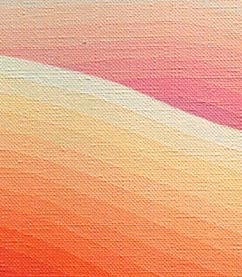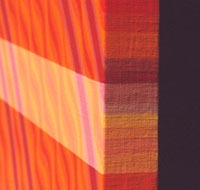
Parallel Universe
A visualization of the various levels of existence, and the interconnectedness of all things. ~~~~~~~~~~~~~~~~
The "parallel" theme works on several different levels:
1. The landscape is repeated one above the other – "as above, so below". Two versions of the one scene.
2. Background and foreground of the one scene. The blue is sky in the top half and water in lower half.
3. Light and dark. (Good and evil.)
4. The two interchanging strips – the light contains a part of the dark and vice versa. A horizontal Yin-Yang.
5. The view of the surface of the land, and the cross section of the geological structure, (external and internal). (Western view and indigenous.)
6. The shading of the form is carried out by using parallel bands of tonal gradation which blend visually at a distance, to give the illusion of form.
7. The painting continues around the edge of the canvas suggesting another dimension. A cross section perpendicular to the foreground cross section.
Detail showing approximate size of the bands of colour.
The painting continues around the edge...
A quote from:
The very word "landscape" involves, from the beginning, an irreconcilable difference of viewpoint, and there seems no word in European languages to overcome the difficulty.
It is a painter's term, implying an outside view, a separation, even a basis of criticism.
We cannot set it against the reality of earth-sky-water-tree-spirit-human complex existing in spacetime, which is the Aboriginal world.
We have unravelled the original continuum into many different elements, and use the word not only in aesthetic contexts, but as a general vague term in geology, botany, and many other disciplines.
To add the further elements of prehistory, history, and future that are bedded in the Dreamtime is to realize how far our world has been fragmented.
What we see in the landscape, then, is a partial, inadequate, and temporal vision, reflecting our own interests.
Oil on Canvas. 2003
102 x 122 cm

Judith Wright, 'Landscape and Dreaming', in R. Graubard (ed.) Australia: The Daedulus Symposium, Angus and Robertson, Sydney, 1985. p. 32.